Local News
“Anti-Zionist” Jews Disgrace Themselves
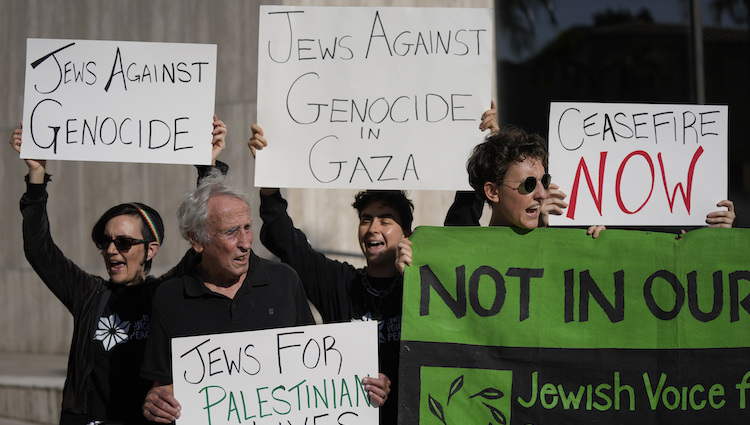
By HENRY SREBRNIK Is so-called “anti-Zionism” antisemitic? It was not always so. Prior to the Holocaust and the creation of a Jewish state, many Jews did consider Zionism – a return to the Land of Israel — unworkable, unnecessary, even wrong-headed. In the United States, prior to the Holocaust, Reform Jews in the American Council for Judaism were committed to the proposition that Jews are not a national but a religious group. Jewish socialists and others on the political left, including the influential Jewish Labour Bund, were opposed to what they thought was an ideological “bourgeois” error.
But these were internal debates in the Diaspora, and in any case most non-Jewish people had little say about them — if they even bothered to pay any attention to these internal arguments within Jewish circles. Nor, obviously, did those politically against the Zionist movement ally with pogromists who slaughtered Jews.
All of that is history, really part of a vanished Jewish world. Yes, there are remnants of that past, in sectors of the haredi world. The Satmar Hasidim are the most visible. They are theologically committed to a reading of Jewish history that considers that the recreation of a Jewish nation must await the Messiah. They are “anti-Zionists” in the legitimate sense of the word, but no one thinks they want to kill the Jews in Israel or elsewhere.
That’s a different matter than today’s Jewish anti-Zionists, who are largely uninformed about Judaism, Jewish history and culture. They are a fringe group, allied with states and ideologies that want to eliminate the existing Jewish state of Israel and perhaps even murder most of its Jewish population and expel the remainder. Today’s version has more to do with pre-war German Nazi eliminationism than with long-forgotten intra-Jewish disputes.
Assimilated into left-wing movements and doctrines, these Jews are in most cases little more than Jews through genealogy, “Jews in name only,” making political use of that on behalf of those wishing to destroy Israel. Their “anti-Zionism” is part of the larger antisemitic movements arrayed against us, and they serve, to use a well-known term, “useful idiots.” They make use of general slogans, identity politics and symbolic statements like wearing a keffiyeh, with minimal complexity and knowledge.
They are producing vast amounts of simplistic one-sided literature and media. One example is the film “Israelism,” the story of two young American Jews “raised to defend the state of Israel at all costs” who “join the movement battling the old guard over Israel’s centrality in American Judaism, and demanding freedom for the Palestinian people.” Call them “Jewish shields” for the pro-Palestinian left that is glorifying the post-October 7 pogrom by Hamas and Islamic Jihad.
“Antisemitism in Canada and abroad is primarily presenting itself through the prism of anti-Zionism, which, in my opinion, is the most pervasive form of antisemitism, and the most perverse in a number of ways,” remarked Casey Babb, a senior fellow with the Macdonald-Laurier Institute and the Institute for National Security Studies. I guess our Jewish “anti-Zionists,” wilfully blinded by the company they keep, refuse to see what’s in front of our eyes.
Fortunately, here in Canada, despite the noise they make, such anti-Zionist Jews are a tiny and marginalized group. Professor Robert Brym of the Department of Sociology at the University of Toronto and probably Canada’s most eminent Jewish academic, on May 30 released an addition to his lengthy “Jews and Israel Survey 2024” published in the spring 2024 issue of the journal Canadian Jewish Studies.
To his question “Do you believe Israel has the right to exist as a Jewish state?” 91 per cent of his Canadian Jewish respondents answered in the affirmative, six per cent said they don’t know, and only three percent said no.
We know the difference between legitimate criticism of Israel and antisemitism. The belief that the Jews, alone among the people of the world, do not have a right to self-determination, or that the Jewish people’s religious and historical connection to Israel is invalid, is inherently bigoted. When Jews are verbally or physically harassed or Jewish institutions and houses of worship are vandalized in response to actions of the State of Israel, it is antisemitism.
Expressions of anti-Zionism include downplaying or negating the historic and spiritual Jewish connection to the land of Israel, and the insistence on holding Israel to unreasonable standards when viewing its response to threats in comparison to the actions of other members of the international community.
Now many of these Jewish anti-Zionists don’t necessarily agree with everything listed above. But by associating and collaborating with those who do, they are at the very least, to use an old-fashioned phrase, “fellow travellers” allied to these antisemitic movements. And they can be paraded before the media as Jews who have seen the evil that Israel causes. What better evidence?
Some of Canada’s most disruptive actions and blockades have been coordinated by groups with U.S. funding and organizational links. For example, the Tides Foundation, a San Francisco-based “social justice” non-profit has supported Jewish Voice for Peace (JVP) and IfNotNow, among others, in the United States. Both have been perennial organizers of anti-Israel rallies and blockades.
The Canadian affiliate of JVP, Independent Jewish Voices Canada, calls itself a “grassroots organization in Canada grounded in Jewish tradition that opposes all forms of racism & advocates for justice and peace for all in Palestine-Israel.” It calls Zionism “the political ideology that has provided the basis for Israel’s settler-colonial project and unfolding genocide in Palestine.”
They are indeed “useful,” and antisemites know it. On May 27, for instance, a representative was on Parliament Hill holding a press conference insisting that the country’s network of pro-intifada campus encampments was not antisemitic.
On June 10 the Public Service Alliance of Canada (PSAC), one of Canada’s largest public sector unions, which is actively engaged in Pro-Palestinian activities, held a discussion “Addressing Islamophobia and antisemitism in the Workplace.” Of course no Jew supporting Israel was invited, not even Deborah Lyons, Canada’s Special Envoy on Holocaust Remembrance and Combating Antisemitism, and a former ambassador to Israel.
The panelists were Amira Elghawaby, Canada’s Special Representative on Combatting Islamophobia, and, on the Jewish side, Avi Lewis, a former Al Jazeera correspondent and now an associate professor of “social and political change” at the University of British Columbia (UBC).
However, Lewis, scion of a prominent family that has been for decades active in the New Democratic Party – grandfather David led the federal NDP and father Stephen was head of the Ontario party — is an active “anti-Zionist,” a member of the anti-Zionist Independent Jewish Voices Canada, and a co-founder of the UBC chapter of the Jewish Faculty Network.
Richard Marceau, vice president of the Centre for Israel and Jewish Affairs, said the union’s efforts at doing something about antisemitism were disappointing.
“Inviting someone like Avi Lewis — who is not an expert on antisemitism, who is a marginal figure in the Jewish community and who is viciously opposed to Israel — to train union members on antisemitism shows how unserious PSAC is about combatting Jew-hatred,” he stated.
Yes, Jews can be Jew-haters too. (The term “self-hating Jew” is silly; they hate other Jews, not themselves.) Such Jews now face anti-Israel sentiment of unprecedented ferocity, often couched in the language of social justice, critical race theory, and so-called intersectionality. It is sustained by the hegemonic hold of a theory of “settler colonialism,” now ubiquitous in Canada’s universities, and one which deems Israel an illegitimate colonial settler state.
And Palestinian academics known how to use this terminology to make their case. Typical is an article by Joseph Massad, a professor of modern Arab politics and intellectual history at Columbia University, New York. In a May 30 oped, “Instead of Recognizing ‘Palestine,’ Countries Should Withdraw Recognition of Israel,” published on the website Middle East Eye, he uses all the correct buzzwords, referring to “Israel’s illegality as an institutionally Jewish supremacist racist state.” He considers the very establishment of this “settler-colonialist” state “an illegal act and in violation of the very UN resolutions that proposed its establishment.”
Massad therefore advocates the “dismantlement of Israel’s racist structures and laws” in favour of “one decolonised state, from the river to the sea, in which everyone living within it is equal before the law and does not benefit from any racial, ethnic, or religious privileges.” Only the end of the Israeli “settler-colonial state” will lead to a “decolonised anti-racist and democratic outcome.”
Massad’s analysis and prescription is the true bedrock Palestinian position, as presented for western ears. (Hamas’ creed is a different matter.) The theoretical construct behind it is one that fits completely within today’s liberal-progressive ideology espoused by the intellectual elites in western countries now. The “anti-Zionist” Jews reading them usually know far less about what the Jewish people have gone through historically. This makes them easy prey for our enemies.
Natan Sharansky, currently Chair of the Institute for the Study of Global Antisemitism and Policy (ISGAP), and McGill University history professor Gil Troy, in a June 16, 2021 Tablet article entitled “The Un-Jews,” asserted that these people “are trying to disentangle Judaism from Jewish nationalism, the sense of Jewish peoplehood.” And the voices of these “inflamed Jewish opponents of Israel and Zionism are in turn amplified by a militant progressive superstructure that now has an ideological lock on the discourse in American academia, publishing, media, and the professions.”
We hear it from progressives like the author Naomi Klein, who is professor of Climate Justice at the University of British Columbia (and married to Avi Lewis). Klein’s Passover message in the April 24 British Guardian newspaper was headlined “We Need an Exodus from Zionism.” She told readers that “we don’t need or want the false idol of Zionism. We want freedom from the project that commits genocide in our name.”
For Klein, Zionism “takes our most profound biblical stories of justice and emancipation from slavery– the story of Passover itself — and turns them into brutalist weapons of colonial land theft, roadmaps for ethnic cleansing and genocide.” The creation of the State of Israel, and the entire Zionist movement, was a ghastly mistake and Jewish life is best led in exile.
“Arguing for the purity of exile and powerlessness, and demanding abandonment of the now-impure Jewish State,” Elliott Abrams, currently a senior fellow for Middle Eastern studies at the Council on Foreign Relations in Washington, observes sadly that “we have indeed been watching the young American Jews who helped build those campus tent cities and joined the denunciations of the Jewish State.”
In “American Jewish Anti-Zionist Diasporism: A Critique,” in the May 2024 issue of the British periodical Fathom, he sees them following the lead of “the hundreds of Jewish professors who wish to proclaim their virtue by lining up against the Jewish State.”
Finally, there are the many Jews like Rabbi Elchanan Poupko, the president of EITAN–the American Israeli Jewish Network, whose anger at anti-Zionists is palpable. In “Anti-Zionist Jews, Have You Seen the Mirror?” a blog published on the Times of Israel website, May 28, 2024, he points out their hypocrisy.
“The people who were angry at Birthright for taking them on a free, all-expenses paid trip to Israel without taking them to Gaza, Ramallah, and Sheikh Jarrah were somehow unable to utter the words Kibbutz Be’eri, Sderot, Metula, Kiryat Shmona, or the massacre at Nova music festival. Those who were angry at their teachers for celebrating Yom Ha’atzmaut with no mention of the Nakba were suddenly unable to speak about the Hamas charter calling for the killing of Jews worldwide.
“Yet perhaps worst of all, was not what anti-Zionist Jews said — or did not say — but rather the company anti-Zionist Jews have chosen to keep. Over the past few months, anti-Zionist Jews have stood shoulder to shoulder with masked and uniformed individuals in public places, physically blocking off ‘Zionists.’”
They exclude their fellow Jews from public spaces in universities, side with terrorist organizations that call for the annihilation of all Jews in the world and make partnerships “with what is objectively the most antisemitic movement since the Holocaust,” he writes.
Rabbi Poupko lives in New Haven, Connecticut. The region is home to Yale University, Quinnipiac University, Albertus Magnus College, the University of New Haven, and Southern Connecticut State University, making it a hub of higher education – and, of course, pro-Palestinian protests. “I got to see firsthand what anti-Zionism in Jewish spaces meant. A group of anti-Zionist Jews shared to their social media videos with cheers like ‘there is only one solution – intifada revolution,’ which is a call for deadly violence.”
As Iran began shooting ballistic missiles and drones carrying hundreds of tons of explosives at Israel’s civilian population, “many anti-Zionist Jews were there to explain why Iran was justified in its attacks on Israel. Jewish Voices for Peace posted a photo of Houthis in Yemen praising the pro-terror mobs on campus.”
He concludes by noting the irony of anti-Zionist Jews siding with the mobs behind the greatest push for Diasporic Jews to move to Israel. “Those who want you to believe Jewish safety should not depend on the State of Israel have helped make much of the diaspora unsafe for Jews and Jewish life.” When the people you march with “are the reason countless synagogues, JCCs, and day schools are hiring more security, you probably don’t get credit for making Jewish life in the Diaspora more appealing.”
Such Jews are betting their present and future will be outside the confines of the Jewish people, and they will do anything to gain the acceptance of the antisemitic circles in which they traffic. “When anti-Zionist Jews hold signs that say: ‘this Jew is against genocide,’ besides for defaming other Jews as being for genocide, they also often forget the truly genocidal company they keep, company that would like to eradicate the State of Israel. It is time for anti-Zionist Jews to take a look in the mirror.”
Bottom line: Whatever we call it, and however they can be distinguished, both terms, antisemitism and anti-Zionism, are in today’s context simply manifestations of Jew- hatred.
Henry Srebrnik is a professor of political science at the University of Prince Edward Island in Charlottetown.
Local News
Thank you to the community from the Chesed Shel Emes
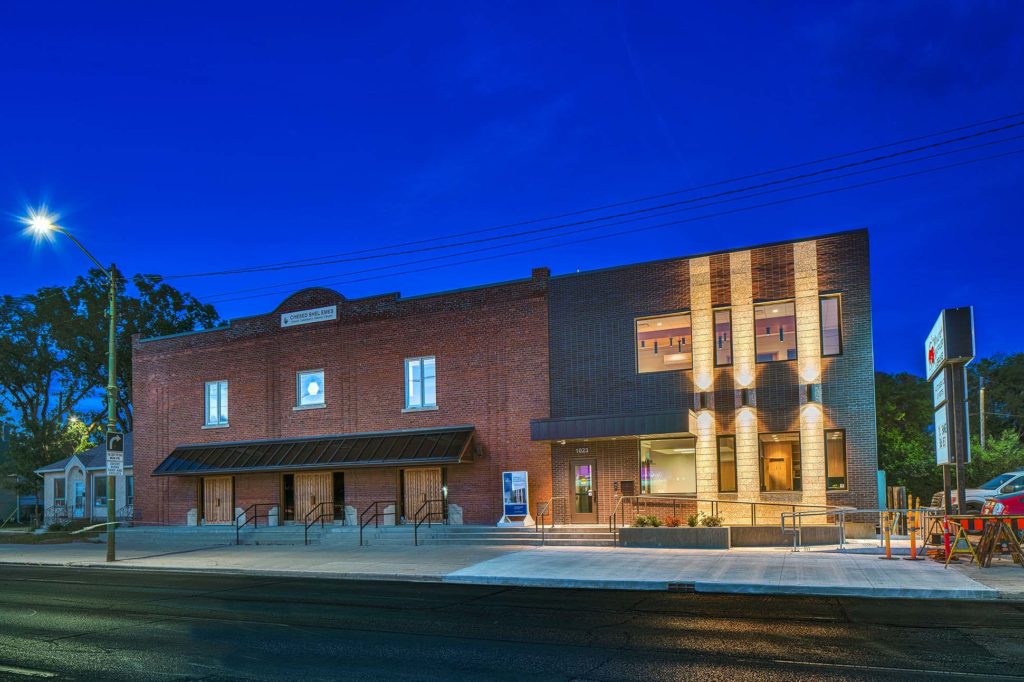
We’re delighted to share a major milestone in our Capital Campaign, “Building on our Tradition.” Launched in November 2018, this campaign aimed to replace our outdated facility with a modern space tailored to our unique needs. Our new building is designed with ritual at its core, featuring ample preparation space, Shomer space, and storage, creating a warm and welcoming environment for our community during times of need.
We’re grateful to the nearly 1,000 generous donors who contributed over $4 million towards our new facility. A $750,000 mortgage will be retired in November 2025, completing this monumental project in just seven years.
We’re also thrilled to announce that our Chesed Shel Emes Endowment Fund has grown tenfold, from $15,000 to $150,000, thanks to you, the Jewish Foundation of Manitoba’s FundMatch program, and Million Dollar Match initiative in 2024. Our fund helps ensure that everyone can have a dignified Jewish funeral regardless of financial need.
As we look to the future, our goal remains to ensure the Chevra Kadisha continues to serve our community for generations to come. Our focus now shifts to replenishing our savings account and growing our JFM Endowment fund.
We’re deeply grateful for your support over the past several years.
It’s our privilege to serve our community with care and compassion.
With sincere appreciation,
Campaign cabinet: Hillel Kravetsky, Gerry Pritchard, Stuart Pudavick,
Jack Solomon, and Rena Boroditsky
Murray S. Greenfield, President
Local News
Winnipeg Beach Synagogue about to celebrate 75th anniversary
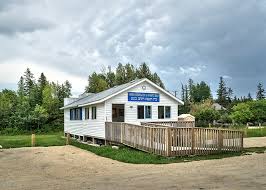
By BERNIE BELLAN (July 13) In 1950 a group of cottage owners at Winnipeg Beach took it upon themselves to relocate a one-room schoolhouse that was in the Beausejour area to Winnipeg Beach where it became the beach synagogue at the corner of Hazel and Grove.
There it stayed until 1998 when it was moved to its current location at Camp Massad.
On August 2nd members of the synagogue will be holding a 75th anniversary celebration.
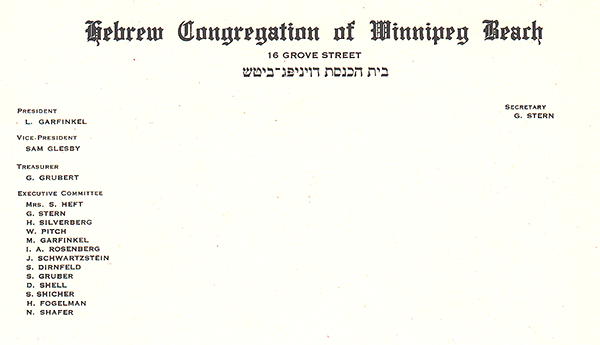
As part of the celebration anyone who is a descendant or relative of any of the original members of the first executive committee (as seen in the photo here) is invited to attend the synagogue that morning.
If you are a relative please contact Abe Borzykowski at wpgbeachshule@shaw.ca or aborzykowski@shaw.ca to let Abe know you might be attending or for more information about the 75th anniversary celebration.
We will soon be publishing a story about the history of the beach synagogue, which is something I’ve been writing about for over 25 years.
Local News
Vickar Family cuts ribbon on new Tova Vickar and Family Childcare Centre
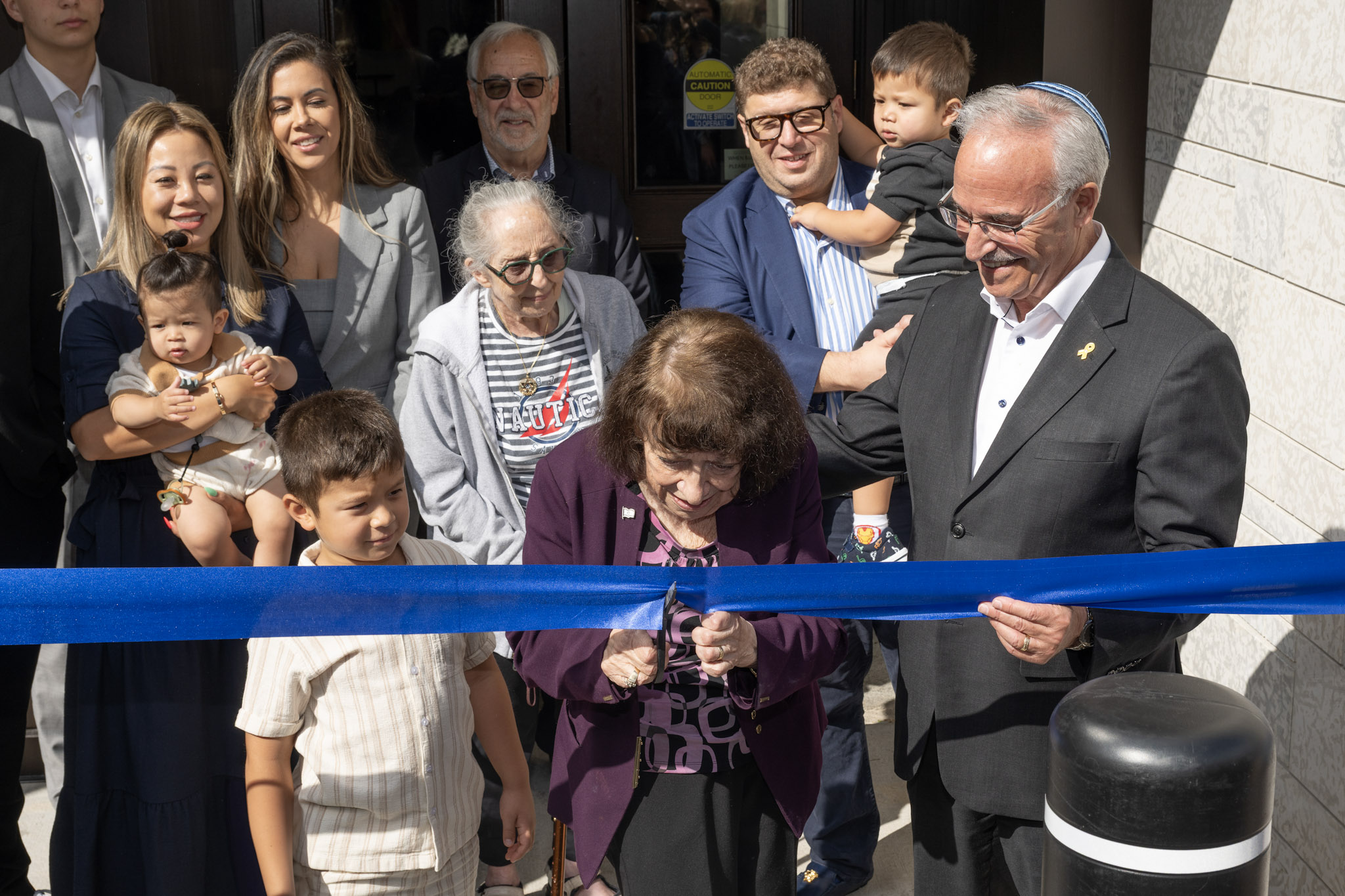
By MYRON LOVE In the words of Larry Vickar, the Shaarey Zedek’s successful Dor V’ Dor Campaign “is not only a renewal of the synagogue but truly a renewal movement of Jewish life in our community.”An integral part of that renewal movement was the creation of a daycare centre within the expanded synagogue. On Monday, June 23, Larry and Tova Vickar cut the ribbon, thereby officially opening the Tova Vickar and Family Childcare Centre in the presence of 100 of their family members, friends and other supporters of the project.
The short program preceding the morning ribbon-cutting began with a continental breakfast followed by a welcome by both Fanny Levy, Shaarey Zedek’s Board President, and Executive Director Dr. Rena Secter Elbaze. In Elbaze’s remarks, she noted that Larry and Tova wanted their family (including son Stephen and family, who flew in from Florida) and friends at the event to celebrate the opening of the Tova Vickar and Family Childcare Centre, “not because of the accolades, but because, as Larry put it, he hopes that their investment in the congregation will inspire others to do the same.”
“When Larry and I spoke about what this gift meant to him and the message he wanted people to take away,” she continued, “I couldn’t help but connect it to the teachings of Reb Zalman Schachter-Shalomi whose book – Age-ing to Sage-ing – changes the whole way we look at the concept of ageing and basing it on our ancestral teachings.”
She explained that his concept of “Sage-ing” is based on three key ideas – Discover your meaning and purpose; accept our mortality and think about the legacy you want to leave.
“Larry spoke about these exact concepts when we met,” she said.
Elbaze also noted the presence of Shaarey Zedek’s newly-arrived senior Rabbi Carnie Rose, former Rabbi Alan Green, and area MLAs Mike Moroz and Carla Compton.
Larry Vickar expressed his great appreciation for all those in attendance. “Tova and I are deeply moved to stand here with you today for this important milestone in our community”, he said. “We are grateful to be surrounded by all of you, the people we care about, our family and friends… you who have touched our lives and played some part in our journey.”
